By Cynthia Unninayar
Among the most popular gems used in today’s “affordable luxury” jewellery designs are amethyst and citrine. When the Brazilian Gems and Jewellery Trade Association (IBGM) recently offered me the chance to join the ICA Mine Tour in Brazil, I welcomed the opportunity to learn more about these and other gems in this gemstone-rich nation. This article recounts the first part of that tour, where a group of 38 people from 13 countries travelled to southern Brazil in search of amethyst and citrine.
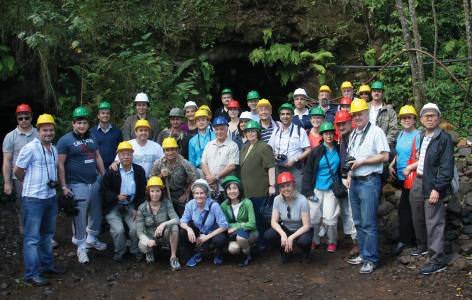
|
| The participants in the ICA Brazil Mine Tour pose for a group photo in front of the entrance to an amethyst mine. |
While amethyst is also mined in Africa and Russia, large concentrations are found in South America, principally in Brazil and neighbouring Uruguay, where the crystals occur in geodes within volcanic rock.
Steeped in legends and myths, the gem’s name is derived from the Greek “amethystos” which can be translated as “not intoxicated.” This supposed antidote against drunkenness is probably why it was used to make wine goblets. Also thought to be a symbol of piety, the purple stone was used in church ornaments during the Middle Ages, and some Catholic bishops still wear amethyst rings today.
Among the gem’s other properties, according to Leonardo Da Vinci, was its ability to dispel evil thoughts and speed up intelligence. Today, amethyst is the birthstone for the Pisces zodiac sign. The lovely colour of the purple stone is also steeped in mythology. Again according to Greek legend, Dionysus—the god of wine—was rebuffed by a maiden named Amethystos, who prayed to the gods to remain chaste. Her prayers were finally answered by the goddess Artemis who turned her into a statue of crystalline white quartz. Touched by her desire to remain pure, Dionysus poured wine over the statue as an offering,thus dying the quartz purple.
This mythological interpretation is quite interesting since amethyst is indeed a variety of quartz (SiO2). But, perhaps a more scientific explanation of the purple colour is the presence of iron impurities in the crystal lattice of the quartz. The shades of purple range from pale, sometimes called “Rose de France,” to beautiful deep violet tones.
En Route to Rio Grande Do Sul
The southern Brazilian state of Rio Grande Do Sul is home to some of the world’s largest amethyst deposits. Our journey started in Chapecó, a major agro-industrial city in the southern state of Santa Catarina, where we boarded a bus that would take us through subtropical pine forests and vegetation, punctuated by vast fields of soybeans (the nation is the world’s largest producer of soybeans) to finally reach the state of Rio Grande Do Sul, and the remarkable little town of Ametista Do Sul.
Mining in this area began in the mid- 1960s by groups of artisanal miners called garimperos. Today, however, since the government allocates mining licenses in a more restrictive and orderly fashion, most amethyst mining is done by cooperatives.
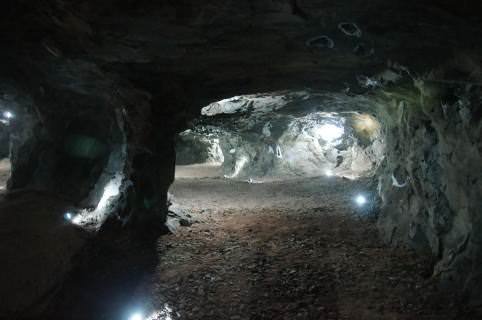
|
| Inside the amethyst mine, large rock pillars regularly support the galleries and tunnels. Broken geodes can be seen on the ceiling and sides.- One of the galleries serves as a wine storage area. (Photos: Pavel Sokolov) |
The mines are composed of underground tunnels, blasted out of volcanic rock, where the amethyst is always found in geodes of various sizes. In other parts of Brazil, however, the gem can be found as crystals in secondary deposits. This gem-rich region extends to Uruguay, where high quality gems are also found. According to our expert guide, Marcelo Bernardes, gems export manager for the Brazilian gems and jewellery company, Manoel Bernardes, some ninety percent of Uruguayan production is purchased by Brazilian gem dealers.
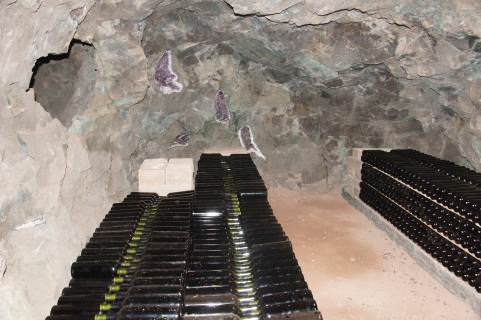
|
Hundreds of mines dot the area, and the one chosen for our visit was unusual since it also serves as a large storage cellar for wine bottles. (It would make both Dionysus and Amethystos proud!) Since this region is also good for growing grapes, and the mine’s owner has a winery, what better place to store the bottles than in the constant cool temperature of an underground mine.
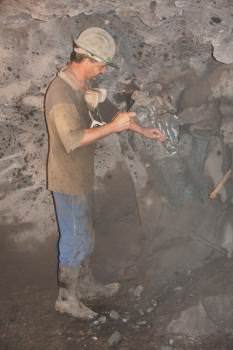
|
| A miner chisels a geode out of the volcanic rock in the mine. (Photo: Pavel Sokolov) |
As we walked through the mine, Marcelo pointed out the thick pillars of volcanic rock that were spaced every two to three meters in order to support the tunnels and chambers. In this particular mine, the geodes are found in slightly tilted or horizontal layers running back about 300 meters to the opposite side of the mountain. When the miners find a geode, they drill a small hole to ascertain its shape and quality. They then carefully and patiently chisel the geode out of the rock, a process that can take hours or even days.
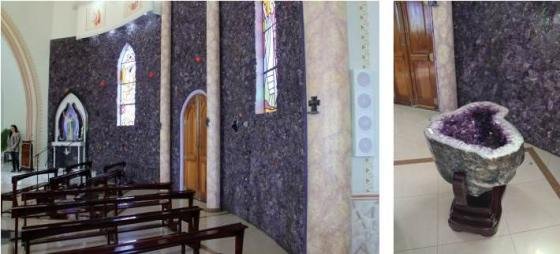
|
| Amethyst crystals cover the walls in St. Gabriel Church.- A baptismal font made from a large geode. (Photos: Hanco Zwaan) |
The highlight of our trip to this area was the picturesque small town of Ametista Do Sul and its main church, St. Gabriel. Rather ordinary looking on the outside, the interior of the small church was a sight to behold. From floor to ceiling, deep violet amethyst crystals covered the walls. The altar and baptismal fonts were made of large geodes of amethyst and citrine. Religious statues and other decorations were framed by other tall geodes. It was a spectacular tribute to the purple gem.
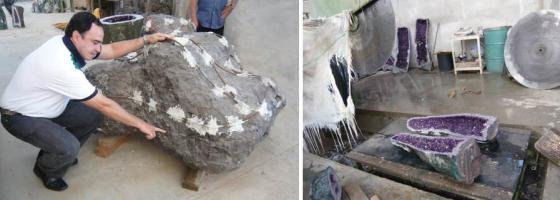
|
| When the geodes arrive at the H&L warehouse, they are reinforced with rebar to avoid breaking. Marcelo Bernardes points to the chalk line, showing where the geode will be sawed. - A large geode has been cut in half with a diamond-tipped saw. (Photos: Cynthia Unninayar) |
Geodes – From Mine to Market
Once the geodes leave the mine, they are taken to a facility such as H&L Minerals. A family owned company with sixty employees, H&L (from the owner’s name, Helio Lodi) deals in a variety of minerals and gems, including agate, various types of quartz (clear, pink, smoky) as well as amethyst, citrine, and prasiolite, plus a range of collector’s pieces. Lodi explained that the company sources from its own mines as well as from third parties. He kindly offered to let the group visit the various steps in the preparation of geodes and gems in the company’s large facility.

|
| Geodes are repaired in the “clinic.”(Photo: Hanco Zwaan) - After sawing, the geodes are polished. - Stippling gives the cement coating a textured look. |
After the geodes arrive at the warehouse, they are sorted. Then, because they can be easily broken, they are reinforced with rebar. Once cemented into place, the steel rods allow the stones to be cut in half using a large diamond-tipped saw. The next step is polishing where the cut surfaces are given a mirror finish. To hide the rebar and provide a more finished appearance, the geodes then pass to the next station where cement is placed all over their rough sides. Lastly, the cemented surface is stippled with a moist brush to give the final textured look.
Since some geodes are broken either at the mine or in transport, they are taken to the “clinic” to be “healed” of holes or other deformities that can decrease their value. With no shortage of crystals to use in repairing the defective geodes, the workers place small pieces of amethyst into the holes like a three-dimensional puzzle and then glue them into place.
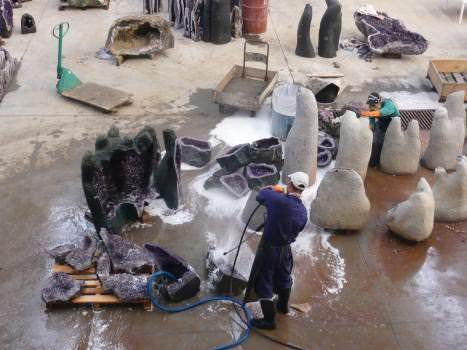
|
| After cementing and stippling, the sides and bottom of the geodes are painted black. They then undergo a final washing. On the right are cemented geodes waiting to be painted. |
The final preparation stage is painting. At H&L Minerals, the stippled areas of the geodes are painted a matt black. When dry, the pieces are washed with soap and water with a high-pressure hose. When dry, they are ready for sale. The warehouse contained rows upon rows of geodes of all sizes waiting to be either sold or shipped.
When asked about the main market for these Brazilian stones, Fernando Lodi, Helio’s son, replied that nearly seventy percent goes to China, with the rest going mainly to the USA and Europe. Leaving the geode area, we ventured into a neighbouring storeroom full of barrels of agates in all sizes and natural colours waiting to be processed.
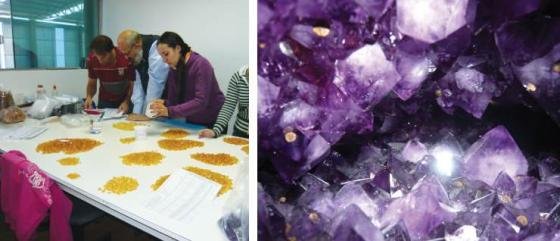
|
| Pavel Sokolov (centre) examines samples of citrine with two H&L employees. - Photo of amethyst crystals taken through a small hole in a large geode. |
At the rear of this large room were vats where some of the agates are dyed— with purple, red, and blue the colours of choice. In other rooms, sorters examined piles of amethyst, citrine, and other quartz crystals.
Hot Rocks – Creating Citrine
Citrine is also a major gemstone coming from this area and derives its name from the Latin “citrina” meaning “yellow.” While natural citrine exists, Marcelo explained that the gem is generally pale yellow to brownish. The deep yellow and orange shades of citrine that are common in geodes and jewellery are generally obtained by heating amethyst. The bicolour purple and yellow ametrine also occurs naturally but is again generally obtained from heating amethyst. (As an aside, one mine in Bolivia produces natural deep colours of ametrine.)
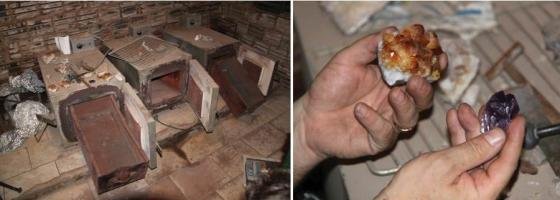
|
| Small ovens are used in “artisanal” operations to convert amethyst to citrine. Insert: Crystals of amethyst before heating, and citrine after heating. (Photo: Hanco Zwaan) |
In the colour transformation process, special furnaces are used to heat individual or small groups of amethyst crystals. The temperatures are carefully increased in ten-degree increments to around 450°C to 500°C until the desired colour is obtained. If the samples are overheated, they will turn colourless. For large geodes, the process is different. They are placed on a ceramic bed, with a bonfire below, surrounded by red-hot coals at carefully controlled temperatures and times to obtain the deep rich orange colour.
In addition to large amethyst treatment facilities, there are also many “backyard” artisanal workshops where quartz and amethyst are treated. We were able to visit one of these small operations and see the little ovens used to heat the samples. Here, workers also chipped away at quartz material to remove inclusions and thus get clear sellable crystals.
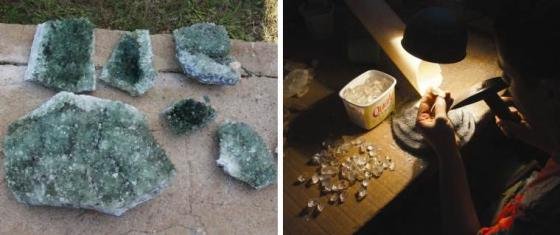
|
| Prasiolite crystals obtaining by irradiating amethyst with gamma rays. (Photo: Pavel Sokolov) - At an artisanal operation, a worker chips away at quartz crystals to get clear sellable pieces. (Photo: Pavel Sokolov) |
Also at this small facility were large crystals and broken geodes of the green-coloured quartz, prasiolite. This gemstone is obtained by using gamma rays to irradiate the amethyst crystals, a process that is conducted in special laboratories in São Paulo.

|
| The incredible Iguaçu Falls between Brazil and Argentina. (Photo: Pavel Sokolov) |
Soledade and Iguaçu Falls
Next on our itinerary was the small town of Soledade, a regional centre for processing geodes, amethyst, citrine, and agates. By chance, we arrived during the annual Exposol, an international gem, jewellery, and mineral show with around 100 exhibitors. (The gem fair is part of a larger exhibition, which also included large farm equipment, clothes, shoes, animals, etc.) After a warm welcome by the fair’s general director and a nice lunch, we were able to see many remarkable specimens, including exquisite sliced agates and rose quartz measuring one to two meters in size, plus all sorts of geodes, collectors’ minerals, and even jewellery. Most of the jewellery was silver, set with gemstones in large bold designs, although smaller agate and drusy pendants were in abundance at inexpensive prices. Among the jewellery designers at the fair was Marlene Lodi of the H&L Minerals family, who specializes in bold silver pieces and agate creations.
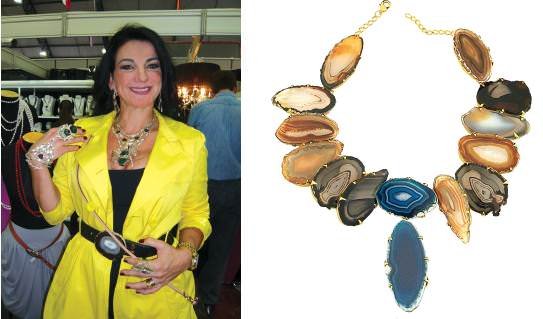
|
| Agate necklace by Marlene Lodi, here modeling her silver designs at Exposal in Soledade. |
The last portion of our tour in the southern part of Brazil found the group in the small city of Foz do Iguaçu. The nearby Iguaçu Falls is clearly one of Brazil’s most famous tourist destinations. These breathtaking waterfalls are located where the Iguaçu River tumbles over the edge of the Paraná Plateau, 23 kilometres upriver from the Iguaçu’s confluence with the Paraná River. More than 275 separate waterfalls (60m to 82m high) are divided between Brazil (one-third) and Argentina (two-thirds).
After visiting the Brazilian side, we enjoyed a thrilling and very wet boat ride under one of the cataracts. The next day, we were off to Argentina to experience a completely different view of the many cascades, especially the incredible Devil’s Throat Falls (82m high, 150m wide, and 700m long).
Learning about the area’s geology and experiencing the incredible Iguaçu Falls provided an unforgettable conclusion to our trip to Brazil in search of amethyst and citrine.







